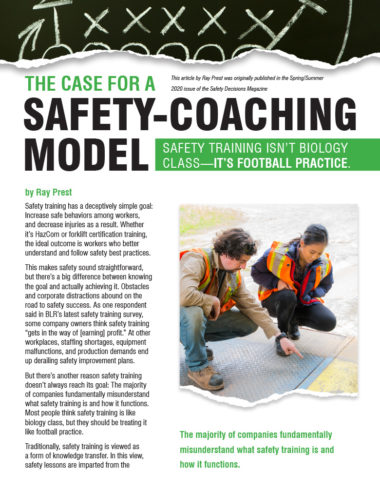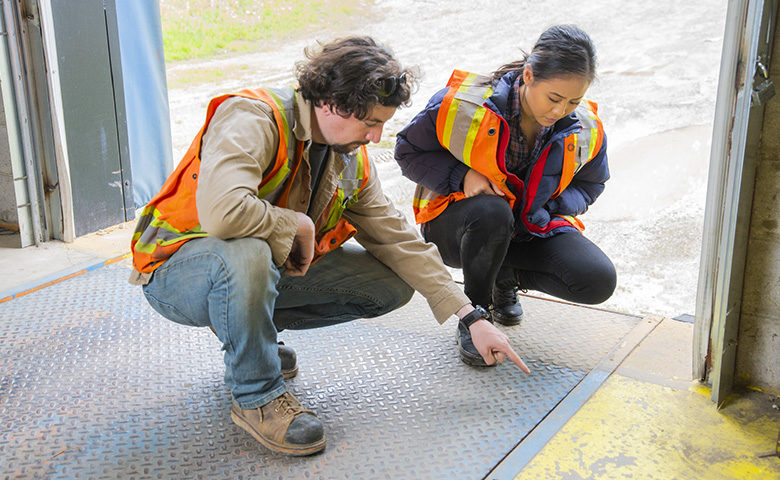This article by Ray Prest was originally published in the
Spring/Summer 2020 issue of the Safety Decisions Magazine
Safety training has a deceptively simple goal: Increase safe behaviors among workers, and decrease injuries as a result. Whether it’s HazCom or forklift certification training, the ideal outcome is workers who better understand and follow safety best practices.
This makes safety sound straightforward, but there’s a big difference between knowing the goal and actually achieving it. Obstacles and corporate distractions abound on the road to safety success. As one respondent said in BLR’s latest safety training survey, some company owners think safety training “gets in the way of [earning] profit.” At other workplaces, staffing shortages, equipment malfunctions, and production demands end up derailing safety improvement plans.
But there’s another reason safety training doesn’t always reach its goal: The majority of companies fundamentally misunderstand what safety training is and how it functions. Most people think safety training is like biology class, but they should be treating it like football practice.
The majority of companies fundamentally misunderstand what safety training is and how it functions.
Traditionally, safety training is viewed as a form of knowledge transfer. In this view, safety lessons are imparted from the instructor to the learners, who then carry that knowledge with them throughout the day.
People take this approach to safety because, generally speaking, knowledge is almost always static. Facts don’t change from one context to the next. The Occupational Safety and Health Administration (OSHA) was founded in 1971. Back injuries can be caused by poor lifting techniques. Hard hats should always be worn in certain areas of the workplace. No matter how you slice it, these facts will always be true.
But knowing what to do with these facts in real time is another story entirely. Learning something in a classroom doesn’t necessarily mean you’ll remember that information, let alone that you’ll be able to effectively use that information on a day-to-day basis. And the goal of safety training—safer actions and fewer injuries—requires a heavy dose of experience and situational awareness to go along with classroom knowledge.
As a safety professional, you may be able to recall the date OSHA was created, but it’s much more important for you to know how to stay in compliance with the latest health and safety laws. Your employees know that back injuries are a result of improper lifting, but can they recognize when their body position is compromised? And being aware of when to wear personal protective equipment (PPE) is easy—but take a look at most workplaces in America, and it’s evident that it’s much harder for workers to remember and care enough to actually put it on.
This is because the information that is taught in safety training is frequently divorced from the situations in which it’s used. So even though your workers have knowledge of something, they’re much less likely to have the requisite practice and awareness to put that knowledge to good use. In BLR’s The State of Safety Training survey, 65% of respondents said their biggest challenge was either reinforcing safety training or identifying safety-related skills gaps among workers. The problem isn’t teaching workers as much as it is getting them to remember what they’ve learned and then putting it into practice.
It’s much more valuable to show players what it feels like to play good defense than it is to tell them how to do it.
 Let’s pause for a moment to take a look at why practice is so important. And to do that, I’d like you to indulge me in a quick look at what happens when football teams practice. They don’t just sit in chairs and watch the coach go through a PowerPoint® slide on how to throw and catch. They don’t just spend hours talking about the rules of good defense. Instead, the coach establishes a few core principles, gets the players to learn the playbook, and then runs drill after drill to instill those values.
Let’s pause for a moment to take a look at why practice is so important. And to do that, I’d like you to indulge me in a quick look at what happens when football teams practice. They don’t just sit in chairs and watch the coach go through a PowerPoint® slide on how to throw and catch. They don’t just spend hours talking about the rules of good defense. Instead, the coach establishes a few core principles, gets the players to learn the playbook, and then runs drill after drill to instill those values.
It’s much more valuable to show players what it feels like to play good defense than it is to tell them how to do it. And because no one knows exactly what will happen in a game situation—what will the other team’s players do? What will the field conditions be?—they run through variations of plays and anticipate different scenarios.
Above all, the coach tries to improve the players’ skills through repetition. Muscle memory is built up. A common purpose is developed. Players are taught to think on the fly, read what’s going on around them, and respond accordingly based on what they see happening in real time. Yes, players are given some knowledge of specific plays and the finer points of the game. But mostly, their ability to perform on a practical level is established, and if the coaches do their jobs right, their skills are improved.
And that brings us back to safety training. Every safety manager’s dream is for frontline workers to be able to accurately assess a potentially dangerous situation in the workplace as it develops and then react accordingly; to have basic skills like wearing PPE built up to habit strength; and to understand the principles of safe behavior and then have them acted on no matter what gets thrown at them during their shift.
For that dream to become a reality, you have to think like a coach, not a teacher. A teacher lectures workers on the various reasons a hard hat is important. A coach makes workers practice putting their hard hat on a thousand times until it becomes second nature—and publicly recognizes people who are doing it properly to reinforce the behavior.
To wrap up the safety-equals football metaphor, I want to point out how many coaches there are on a professional team. Long gone are the days when single coaches ran entire teams on their own. Now, a host of assistant coaches, trainers, and coordinators help the head coach run drills, plan strategy, and monitor players.
When it comes to the workplace, many safety folks are departments of one. Even those with safety colleagues often feel like there’s not enough help to go around. But one thing every sizable organization has is supervisors.
Supervisors play a pivotal role in disseminating—or blocking—your safety message. They are your eyes and ears on the ground, spotting things that might otherwise go unnoticed. And they’re in an ideal position to provide hands-on guidance to workers on safety-related matters. But supervisors can only be your safety coaches if they have the skills and knowledge to do so. After all, you can’t coach someone on something you don’t know about yourself.
Treating your employees as a team instead of pupils will allow you to gain more traction with your safety training.
In my experience, successful supervisor-coaches all possess the same three traits: communication skills, knowledge of human factors, and the ability to intervene in a positive, constructive way in a variety of safety-related situations. Providing training to augment these traits in your supervisors will give you reliable safety coaches throughout your organization. (And it will improve their general supervisory skills, too, which benefits production and other organizational priorities.)
Treating your employees as a team instead of pupils will allow you to gain more traction with your safety training, regardless of the specific content you’re training on. And if you start by enhancing the abilities of your supervisors, then you’ll be well on your way to establishing a sustainable safety-coaching model.
Ray Prest is the Director of Marketing at SafeStart, a safety company focused on human factors solutions that reduce preventable deaths and injuries on and off the job. A columnist for Safety Decisions since 2015, Ray’s been helping people learn about safety and training for over 20 years. Read more at safestart.com/ray.

Get the PDF version
You can download a printable PDF of the article using the button below.

